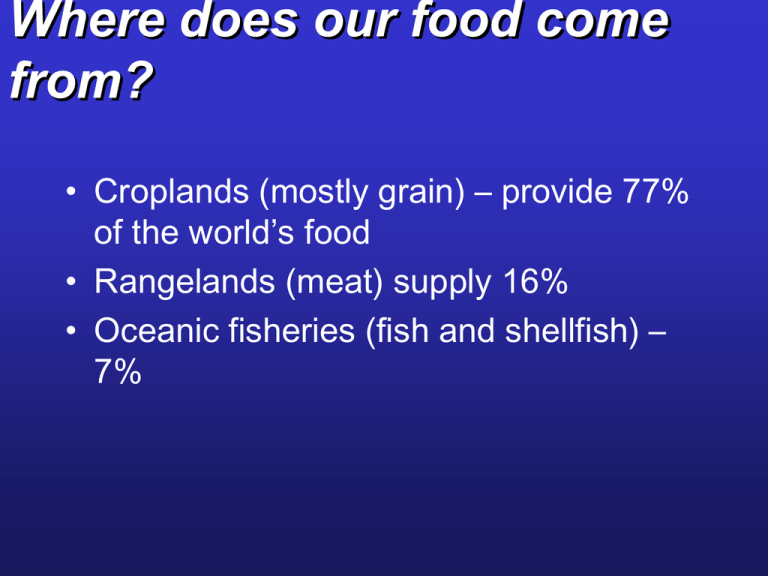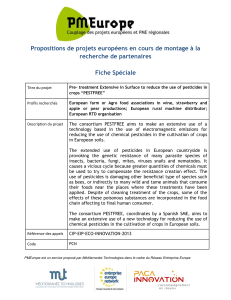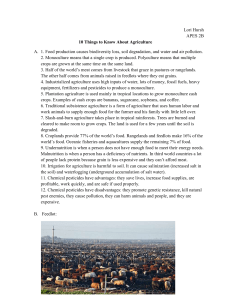Where does our food come from?
advertisement

Where does our food come from? • Croplands (mostly grain) – provide 77% of the world’s food • Rangelands (meat) supply 16% • Oceanic fisheries (fish and shellfish) – 7% How Is Food Produced? • Sources of food • Primary plants: Wheat, corn, and rice • Primary animals: fish, beef, pork, and chicken • 14 plant and 8 animal species provide 90% of the global food calories Major Types of Agriculture • Industrialized agriculture • Large amounts of fossil fuel, water, fertilizer, and pesticides to produce monoculture crops or livestock animals • Plantation • Form of industrialized agriculture – single ownership • Traditional subsistence agriculture – Produce only enough for the family • Traditional intensive agriculture – Increase outputs for profit Industrialized Agricultural Wastes and Land Pollution • Animal Confinement – Waste runoff • Overgrazing – Increases soil erosion • • • • Sedimentation Nutrient application Irrigation Pesticides Waste runoff increases nutrients and pathogens in streams Overgrazing typically strips the land of any natural protection and leaves the soil very susceptible to erosion Runoff carries sediments, nutrients and pesticides into streams that damages fish habitat Agriculture alters native habitats and reduces native biodiversity Major Types of Agriculture • Plantation - Form of agriculture that involves concentrated ownership of land with the means of production in the hands of one family or corporation, the use of hired labor, and mono-crop production for sale. • Cash crops mostly for sale in developed countries • Bananas, coffee, soybeans Traditional Industrialized Plantation World Food Production ustrialized Traditional Producing Food by GreenRevolution Techniques • Since 1950, increase in global food production has come from increased yields per unit area of crop land. Producing Food by GreenRevolution Techniques • Green revolution involves three steps: 1. High-input monoculture using selectively bred or genetically-engineered crops 2. High yields using high inputs of fertilizer, extensive use of pesticides and high inputs of water 3. Multiple cropping – increase the number of crops grown per year on a plot of land. Green Revolutions First green revolution Second green revolution (developed countries) (developing countries) Major International agricultural research centers and seed banks Producing Food by Traditional Techniques Interplanting – simultaneously grow several crops on the same ground. Reduces chance of losing year’s crop to pests, bad weather, etc. Producing Food by Traditional Techniques • Types of Interplanting – Polyvarietal cultivation – planting several varieties of the same crop – Intercropping – grow two or more different crops at the same time (grain+nitrogen fixing plant) – Agroforestry (alley cropping) – crops and trees are grown together – Polyculture – many different types of plants that mature at different times are grown together Causes of Soil Erosion • Wind • Water • People – farming, logging, construction (or any activities that weaken root strength) Soil erosion in a wheat field Global Soil Erosion Areas of serious concern Areas of some concern Stable or nonvegetative areas Soil Degradation on Irrigated Land • Salinization • Waterlogging Evaporation Evaporation Transpiration Waterlogging Less permeable clay layer Reducing and Cleaning Up Salinization • • • • • Reduce irrigation Switch to salt-tolerant crops Flush soils Not growing crops for 2-5 years Install underground drainage Saltwater and drainage is a continual problem for lowland agriculture near Puget Sound. Tidegate – lets water out, but not back in. Solutions: Soil Conservation Soil Restoration • • • • • Organic fertilizer Animal manure Green manure – fresh cut vegetation Compost Crop rotation – legume crops add nitrogen to soil • Commercial inorganic fertilizer Catching and Raising More Fish • • • • • • Fisheries Fishing methods Overfishing Commercial extinction Aquiculture Fish farming and ranching Pesticides: Types • • • • • Chemicals that kill undesirable organisms Insecticides - insects Herbicides - plants Fungicides - fungus Rodenticides - rodents First Generation Pesticides • Primarily natural substances • Sulfur, lead, arsenic, mercury • Plant extracts: nicotine, pyrethrum Second Generation Pesticides • Primarily synthetic organic compounds • Broad-spectrum agents – toxic to many species • Narrow-spectrum agents – toxic to few species • Persistence in the environment The Case for Pesticides • • • • Save human lives – spread of disease Increase food supplies and lower costs Work better and faster than alternatives Health risks may be insignificant compared to benefits • Newer pesticides are becoming safer • New pesticides are used at lower rates Characteristics of an Ideal Pesticide • • • • • Affects only target pests Harms no other species No genetic resistance Breaks down quickly in the environment Be more cost-effective than doing nothing The Case Against Pesticides • Genetic resistance • The pesticide treadmill – pay more for less effect • Can kill non-target and natural control species • Can cause an increase in other pest species • Pesticides do not stay put • Can harm wildlife • Potential human health threats Bioaccumulation and Biomagnification • Persistent (nonbiodegradable) toxins build up in an animal over time = bioaccumulation • Become more concentrated at higher trophic levels = biomagnification Integrated Pest Management • Ecological system approach • Reduce pest populations to economic threshold • Field monitoring of pest populations • Use of biological agents – natural predators, parasites, disease • Chemical pesticides are last resort Why is Integrated Pest Management not More Widely Used? • Requires expert knowledge • Slower than conventional pesticides • Initial costs may be high • Hindered by pesticide industry Solutions: Sustainable Agriculture • Low-input agriculture • Organic farming • Profitable • Increasing funding for research in sustainable techniques






